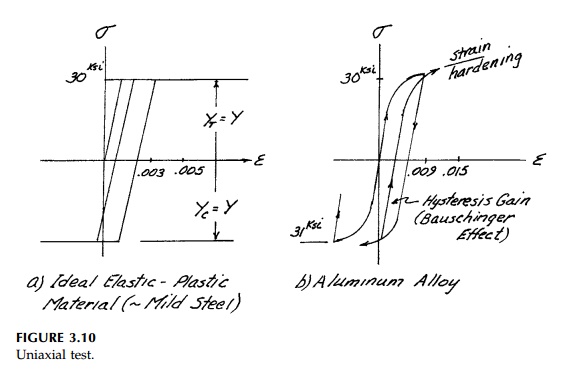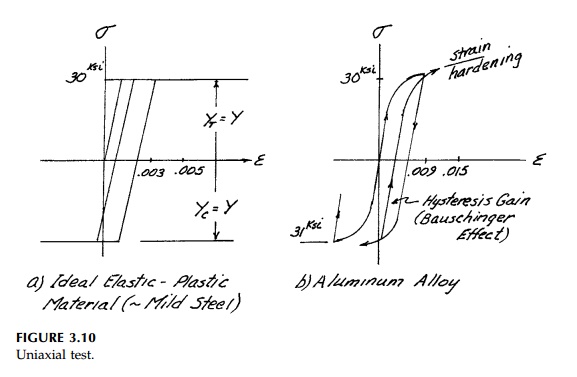Chapter: Civil : Principles of Solid Mechanics : Stress-Strain Relationships (Rheology)
Elasticity and Plasticity

Elasticity and
Plasticity
The fundamental
assumption, which allows us to develop the relative deformation tensor Eij = ![]() ij
+
ij
+ ![]() ij
in previews pages, is that displacements (u, v, w) are small,
continuous, and very smooth. Thus, over differential base lengths, deformations
are linear. When this is no longer true (kinks develop in the displacement
field) or is a bad approximation, we define that condi-tion as yield. If
we couple this with the assumption of a linear stress-strain behavior* we have
completed our development of a 'basic' or simple 'The-ory of Elasticity.' The
yield condition provides the end point or boundary of the 'elasticity domain.'
The 9 field equations (in 3D) relating strain and rotation to displacement and
the 6 stress-strain relations can still be used in regions of the blob that
have not yielded, but to describe the overall behav-ior, the 'Theory of
Plasticity' must be introduced.** The 'field problem' of determining u, v,
w throughout a structure after the 'loads' first cause yield becomes nonlinear
and is very difficult in closed form (and thus one of the prime areas where
numerical methods thrive). We will discuss post-yield behavior and derive
approximate plasticity solutions (and a few exact ones) in later pages.
ij
in previews pages, is that displacements (u, v, w) are small,
continuous, and very smooth. Thus, over differential base lengths, deformations
are linear. When this is no longer true (kinks develop in the displacement
field) or is a bad approximation, we define that condi-tion as yield. If
we couple this with the assumption of a linear stress-strain behavior* we have
completed our development of a 'basic' or simple 'The-ory of Elasticity.' The
yield condition provides the end point or boundary of the 'elasticity domain.'
The 9 field equations (in 3D) relating strain and rotation to displacement and
the 6 stress-strain relations can still be used in regions of the blob that
have not yielded, but to describe the overall behav-ior, the 'Theory of
Plasticity' must be introduced.** The 'field problem' of determining u, v,
w throughout a structure after the 'loads' first cause yield becomes nonlinear
and is very difficult in closed form (and thus one of the prime areas where
numerical methods thrive). We will discuss post-yield behavior and derive
approximate plasticity solutions (and a few exact ones) in later pages.
It is very important to
emphasize that engineers generally do no want their structures to yield***
since once yield has occurred the structure is perma-nently deformed, residual
stresses are usually introduced, and fatigue life is drastically reduced. Thus
designers apply some factor of safety to the yield condition so that under
'working loads' the structure operates in the elastic range. Thus a definition
of yield and its laboratory determination is as impor-tant an engineering
property as E and v (or G and K)
in using elastic analysis for design.

Related Topics